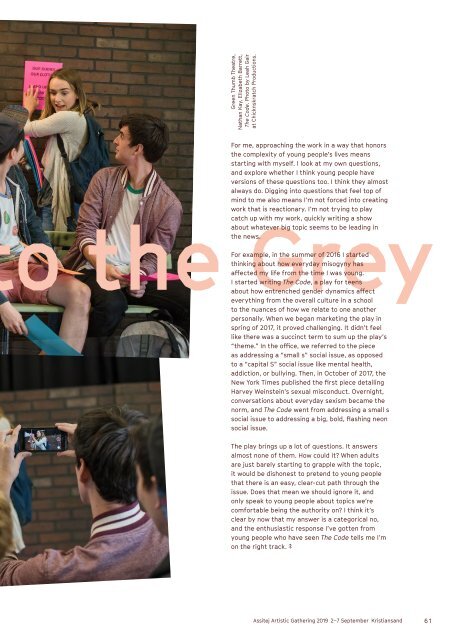ASSITEJ Magazine 2019
This is the annual ASSITEJ magazine, launched during the ASSITEJ Artistic Gathering 2019 in Kristiansand (Norway). It contains high-quality articles on theatre for young audiences from all corners of the world!
This is the annual ASSITEJ magazine, launched during the ASSITEJ Artistic Gathering 2019 in Kristiansand (Norway). It contains high-quality articles on theatre for young audiences from all corners of the world!
You also want an ePaper? Increase the reach of your titles
YUMPU automatically turns print PDFs into web optimized ePapers that Google loves.
Green Thumb Theatre,<br />
Nathan Kay, Elizabeth Barrett,<br />
The Code. Photo by Leah Gair<br />
at Chicknskratch Productions.<br />
For me, approaching the work in a way that honors<br />
the complexity of young people’s lives means<br />
starting with myself. I look at my own questions,<br />
and explore whether I think young people have<br />
versions of these questions too. I think they almost<br />
always do. Digging into questions that feel top of<br />
mind to me also means I’m not forced into creating<br />
work that is reactionary. I’m not trying to play<br />
catch up with my work, quickly writing a show<br />
about whatever big topic seems to be leading in<br />
the news.<br />
o the Grey<br />
For example, in the summer of 2016 I started<br />
thinking about how everyday misogyny has<br />
affected my life from the time I was young.<br />
I started writing The Code, a play for teens<br />
about how entrenched gender dynamics affect<br />
everything from the overall culture in a school<br />
to the nuances of how we relate to one another<br />
personally. When we began marketing the play in<br />
spring of 2017, it proved challenging. It didn’t feel<br />
like there was a succinct term to sum up the play’s<br />
“theme.” In the office, we referred to the piece<br />
as addressing a “small s” social issue, as opposed<br />
to a “capital S” social issue like mental health,<br />
addiction, or bullying. Then, in October of 2017, the<br />
New York Times published the first piece detailing<br />
Harvey Weinstein’s sexual misconduct. Overnight,<br />
conversations about everyday sexism became the<br />
norm, and The Code went from addressing a small s<br />
social issue to addressing a big, bold, flashing neon<br />
social issue.<br />
The play brings up a lot of questions. It answers<br />
almost none of them. How could it? When adults<br />
are just barely starting to grapple with the topic,<br />
it would be dishonest to pretend to young people<br />
that there is an easy, clear-cut path through the<br />
issue. Does that mean we should ignore it, and<br />
only speak to young people about topics we’re<br />
comfortable being the authority on? I think it’s<br />
clear by now that my answer is a categorical no,<br />
and the enthusiastic response I’ve gotten from<br />
young people who have seen The Code tells me I’m<br />
on the right track.<br />
Assitej Artistic Gathering <strong>2019</strong> 2–7 September Kristiansand<br />
61



